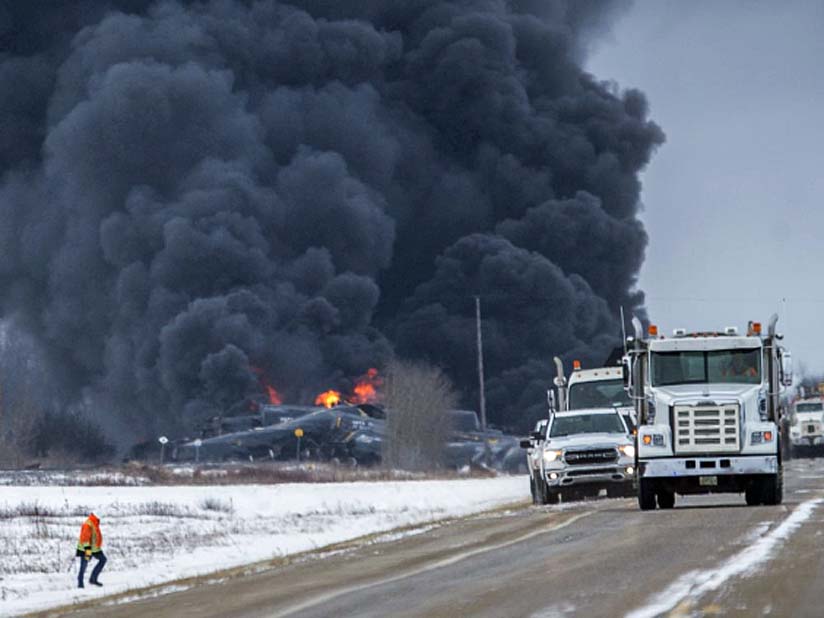
Saskatoon Saskatchewan - Saskatoon officials say the possibility of a fiery derailment on rail lines running through the city is
"highly unlikely", but at least one expert believes more could be done to reduce the risk of a crude carrying train going off the
rails.
Bruce Campbell said the Canadian railway industry is still skewed toward economics rather than safety, even after the federal government imposed new, lower
speed limits following a pair of derailments near Saskatoon, both of which resulted in major fires.
"It is a kind of a question of Russian roulette, not if, but when and where," said Campbell, an adjunct professor at York University who wrote a book
about the 2013 railway disaster in Lake Megantic in which a "runaway" train derailed and exploded, killing 47 people.
"The window is still open for history to repeat itself," he added.
Federal Transport Minister Marc Garneau imposed new, lower, speed limits for long trains carrying dangerous goods last month, after a second oil laden Canadian
Pacific Railway (CP) train derailed and burst into flames near Guernsey, 100 kilometres east of Saskatoon.
Campbell said Transport Canada (TC), which regulates the railways, could do more to reduce wear on rails by making trains shorter and lighter, increasing
inspections, improving safety oversight, and tackling fatigue management, a pivotal issue in the recent CN workers' strike.
Even new, state-of-the-art tank cars have burst into flames after derailments, like the second Guernsey incident on 6 Feb 2020 he pointed out.
Ian Naish, a former director of rail investigations at the Transportation Safety Board of Canada (TSB) who now runs a private transportation consultancy, took
a more circumspect view, saying "time will tell" if the new speed limits are enough to prevent further incidents.
"There are regulations that are out there. It might be time to have a look at them and see if there are any place they can be tidied up, in terms of
increased inspections, or changing the levels of tolerances for rails, or maintenance requirements," Naish said.
TC spokesman Simon Rivet said the department is determining what additional measures will need to be in place once Garneau's speed limit order expires on
31 Mar 2020, he said "regular inspection activities" are ongoing.
 It was reported
some time ago that the speed limit restriction has already been lifted.
It was reported
some time ago that the speed limit restriction has already been lifted.
The City of Saskatoon's director of emergency management, Pamela Goulden-McLeod, characterized a Guernsey-style derailment in the city as a "black
swan," an emergency response industry term for a worst case scenario, one she emphasized is not likely.
Goulden-McLeod said, the city is constantly refining its plans for coordinating the response to a major railway incident and consulting with
"partners," including the railways.
While there have not been major changes since the Guernsey derailments, the city is planning a "tabletop exercise," a dry run to ensure everything
from incident command to cleanup runs smoothly if a major incident should occur. We're always striving to do things better," she said.
Naish said that is what he believes cities should be doing.
Asked whether people living near tracks in Saskatoon should be worried, he replied that "they should be aware of it" and said everyone has their own
level of risk tolerance.
Pointing to railway safety citizens' groups that sprang up in Toronto to dig up and demand more information about railway traffic through the city and the
country's lack of an independent regulator, Campbell said more information should be publicly available.
"Sunshine tends to precipitate a reaction."
CP previously reported that 12.4 percent of its 2018 shipments contained dangerous goods, such as crude oil.
CP spokesman Andy Cummings said the railway is "fully complying" with Garneau's order to reduce speeds.
Canadian National Railway (CN) said 10.3 percent of its shipments last year consisted of dangerous goods.
In Saskatchewan, crude oil made up 39 percent of all dangerous goods shipped in 2019, the railway reported publicly.
In a statement, a CN spokesman said the railway works with communities and first responders, analyzes response measures, shares information, and uses the
AskRail app, which provides information to emergency crews about hazardous materials trains are carrying.
Neither railway provided specific data about trains running through Saskatoon.
Alex MacPherson.
provisions in Section 29 of the Canadian
Copyright Modernization Act.

